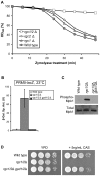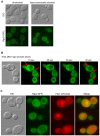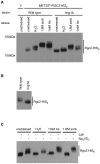Identification of positive regulators of the yeast fps1 glycerol channel
- PMID: 19956799
- PMCID: PMC2773846
- DOI: 10.1371/journal.pgen.1000738
Identification of positive regulators of the yeast fps1 glycerol channel
Abstract
The yeast Fps1 protein is an aquaglyceroporin that functions as the major facilitator of glycerol transport in response to changes in extracellular osmolarity. Although the High Osmolarity Glycerol pathway is thought to have a function in at least basal control of Fps1 activity, its mode of regulation is not understood. We describe the identification of a pair of positive regulators of the Fps1 glycerol channel, Rgc1 (Ypr115w) and Rgc2 (Ask10). An rgc1/2Delta mutant experiences cell wall stress that results from osmotic pressure associated with hyper-accumulation of glycerol. Accumulation of glycerol in the rgc1/2Delta mutant results from a defect in Fps1 activity as evidenced by suppression of the defect through Fps1 overexpression, failure to release glycerol upon hypo-osmotic shock, and resistance to arsenite, a toxic metalloid that enters the cell through Fps1. Regulation of Fps1 by Rgc1/2 appears to be indirect; however, evidence is presented supporting the view that Rgc1/2 regulate Fps1 channel activity, rather than its expression, folding, or localization. Rgc2 was phosphorylated in response to stresses that lead to regulation of Fps1. This stress-induced phosphorylation was partially dependent on the Hog1 MAPK. Hog1 was also required for basal phosphorylation of Rgc2, suggesting a mechanism by which Hog1 may regulate Fps1 indirectly.
Conflict of interest statement
The authors have declared that no competing interests exist.
Figures








Similar articles
-
Rgc2 Regulator of Glycerol Channel Fps1 Functions as a Homo- and Heterodimer with Rgc1.Eukaryot Cell. 2015 Jul;14(7):719-25. doi: 10.1128/EC.00073-15. Epub 2015 May 29. Eukaryot Cell. 2015. PMID: 26024902 Free PMC article.
-
MAPK Hog1 closes the S. cerevisiae glycerol channel Fps1 by phosphorylating and displacing its positive regulators.Genes Dev. 2013 Dec 1;27(23):2590-601. doi: 10.1101/gad.229310.113. Genes Dev. 2013. PMID: 24298058 Free PMC article.
-
Down-regulation of TORC2-Ypk1 signaling promotes MAPK-independent survival under hyperosmotic stress.Elife. 2015 Aug 14;4:e09336. doi: 10.7554/eLife.09336. Elife. 2015. PMID: 26274562 Free PMC article.
-
Yeast go the whole HOG for the hyperosmotic response.Trends Genet. 2002 Aug;18(8):405-12. doi: 10.1016/s0168-9525(02)02723-3. Trends Genet. 2002. PMID: 12142009 Review.
-
Osmoregulation in Saccharomyces cerevisiae via mechanisms other than the high-osmolarity glycerol pathway.Microbiology (Reading). 2016 Sep;162(9):1511-1526. doi: 10.1099/mic.0.000360. Epub 2016 Aug 23. Microbiology (Reading). 2016. PMID: 27557593 Review.
Cited by
-
Osmostress-induced cell volume loss delays yeast Hog1 signaling by limiting diffusion processes and by Hog1-specific effects.PLoS One. 2013 Nov 20;8(11):e80901. doi: 10.1371/journal.pone.0080901. eCollection 2013. PLoS One. 2013. PMID: 24278344 Free PMC article.
-
Regulation of cell wall biogenesis in Saccharomyces cerevisiae: the cell wall integrity signaling pathway.Genetics. 2011 Dec;189(4):1145-75. doi: 10.1534/genetics.111.128264. Genetics. 2011. PMID: 22174182 Free PMC article. Review.
-
Systems Level Analysis of the Yeast Osmo-Stat.Sci Rep. 2016 Aug 12;6:30950. doi: 10.1038/srep30950. Sci Rep. 2016. PMID: 27515486 Free PMC article.
-
An update on receptor-like kinase involvement in the maintenance of plant cell wall integrity.Ann Bot. 2014 Oct;114(6):1339-47. doi: 10.1093/aob/mcu043. Epub 2014 Apr 10. Ann Bot. 2014. PMID: 24723447 Free PMC article. Review.
-
Crosstalk between Saccharomycescerevisiae SAPKs Hog1 and Mpk1 is mediated by glycerol accumulation.Fungal Biol. 2020 May;124(5):361-367. doi: 10.1016/j.funbio.2019.10.002. Epub 2019 Oct 16. Fungal Biol. 2020. PMID: 32389298 Free PMC article.
References
-
- Nevoigt E, Stahl U. Osmoregulation and glycerol metabolism in the yeast Saccharomyces cerevisiae. FEMS Micro Rev. 1997;21:231–241. - PubMed
-
- Kayingo G, Wong B. The MAP kinase Hog1p differentially regulates stress-induced production and accumulation of glycerol and D-arabitol in Candida albicans. Microbiology. 2005;151:2987–2999. - PubMed
-
- Tamas MJ, Luyten K, Sutherland FCW, Hernandez A, Albertyn J, et al. Fps1p controls the accumulation and release of the compatible solute glycerol in yeast osmoregulation. Molec Micro. 1999;31:1087–1104. - PubMed
Publication types
MeSH terms
Substances
Grants and funding
LinkOut - more resources
Full Text Sources
Molecular Biology Databases

